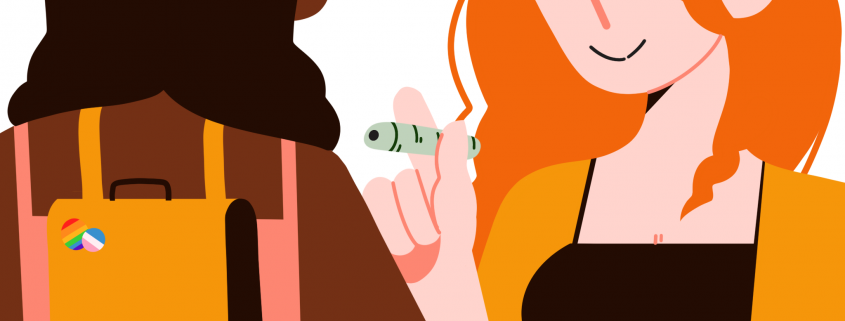To Be Blunt: Cannabis culture prides itself on LGBTQ activism

Weed is for gays and girls only. Sorry, I don’t make the rules.
OK, let me backtrack a little.
Cannabis has long been emblematic of la résistance. For many generations, the government has racialized and criminalized weed, and the substance’s deliberate use in many political upheavals, such as counterculture, is not a coincidence. Even as legalization seems poised to sweep the country in the next few years, the issue of weed is inseparable from socioeconomic justice issues.
With this in mind, it comes as no surprise that the cannabis movement and the gay rights movement were and are heavily intertwined. The most direct connection is cannabis’ use as treatment for AIDS, which disproportionately affected the LGBTQ community. Given federal and local governments’ unwillingness to acknowledge the virus’ existence and effect on a community it deemed expendable, patients with AIDS turned to cannabis for relief — both from the disease itself and the drugs they were prescribed, which were often just as harmful.
Aside from this link, the two movements both gained ground around the same time and advocated for disenfranchised, outcast populations, working to radically shift what society perceived as deviant and delinquent. Without the intensive, dangerous labor of queer activists, weed would not be as (relatively) accessible as it is today.
One such activist was the late Dennis Peron, who is now widely regarded as the father of the medical marijuana movement. Peron’s weed activism began in the 1970s but was greatly amplified amid the AIDS epidemic in the ’80s and ’90s. As a resident of the Castro District in San Francisco, a historically gay neighborhood, the crisis unfolded around him; when his former partner Jonathan West was dying of AIDS, he found that cannabis eased West’s nausea, depression, anxiety, pain and cachexia — or wasting syndrome.
After West’s death, Peron threw himself into cannabis activism. He founded the Cannabis Buyers’ Club, a medical dispensary that became a hub for AIDS and terminally ill patients alike, and he co-authored and secured the passage of the Compassionate Use Act of 1996 in California, the first successful medical marijuana referendum measure in the United States.
Peron’s work was aided by fellow cannabis rights activist Mary Jane Rathbun, an ally to the LGBTQ community. Rathbun, who quickly became known as Brownie Mary, secretly distributed pot brownies to patients as a hospital volunteer for the Shanti Project, the first organization to offer medical services to AIDS patients. At the height of the epidemic, Rathbun baked nearly 600 brownies a day and was arrested multiple times, forcing her nonprofit business underground. After one of Rathbun’s testimonies following an arrest in the early 1990s, the San Francisco Board of Supervisors adopted a resolution to make medical cannabis possession the lowest priority offense.
Paul Scott, another activist who formed an integral part of the gay community advocating for cannabis in San Francisco, created the first medical marijuana facility in Inglewood, helping terminally ill patients cope through cannabis and support groups. Scott also helped found Los Angeles’ Black Gay Pride organization and continues to advocate for queer people of color in the industry today.
While activists such as Peron, Rathbun and Scott paved the way for greater cannabis rights, weed remains a dominant LGBTQ issue. Although queer people advocate for and use cannabis at higher rates than straight people — coexisting with queer individuals’ higher rates of depression, anxiety and post-traumatic stress disorder as a result of oppression — LGBTQ leadership in the cannabis industry remains lacking. As cannabis becomes increasingly recognized as a legitimate business endeavor, corporations dominated by wealthy white cisgender men actively push queer individuals and people of color out of entrepeneurship — an insult to the communities that paved the way for cannabis accessibility.
The intersection of LGBTQ and cannabis rights is particularly relevant in southern states, where more than 60% of all Black queer men diagnosed with HIV nationally reside, according to 2014 data from the Centers for Disease Control and Prevention, and where recreational cannabis use remains largely illegal and medical use is legal in roughly half the region. And, of course, it is well known that backwards legislation and restricted liberties affect disenfranchised communities, whether queer, poor or disabled, at higher rates than privileged ones — a reality that does not skip the cannabis industry.
While queer people make up the historical backbone of the industry, we are routinely exploited, pandered to through pinkwashing or straight-up ignored. With Pride Month in full swing, we have to face yet another onslaught of tacky rainbow packaging and technicolor edibles that serve as nothing more than distractions for employers’ abysmal hiring records among the LGBTQ community.
There’s no reason we should be begging the industry for a seat at a table when we created its infrastructure in the first place. Before weed was co-opted and whitewashed by the bigoted cishet male stoner persona, it was ours. With a purchasing power of $5.4 trillion, LGBTQ folks can and should buy their cannabis from queer-owned shops and inclusive companies where they see themselves represented.
So, to my queer friends, especially my fellow bisexual women (because, apparently, we smoke the most weed out of all demographics), keep getting smoked out by straight men for free. We deserve it.
Natalie Oganesyan is a rising senior writing about weed culture and politics. She is also the editor-in-chief of Summer Trojan. Her column,“To Be Blunt,” runs every other Wednesday.

